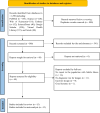Prevalence of dengue in febrile patients in Peru: A systematic review and meta-analysis
- PMID: 40526741
- PMCID: PMC12173410
- DOI: 10.1371/journal.pone.0310163
Prevalence of dengue in febrile patients in Peru: A systematic review and meta-analysis
Abstract
Background: Dengue is an acute febrile illness that is a significant public health problem. Peru is an endemic region for vector-borne diseases such as dengue, zika, and chikungunya, which initially manifest with febrile illness and can complicate differential diagnosis. Therefore, the present study aimed to determine the prevalence of positive results for dengue or dengue antibodies in Peruvian patients with febrile illness using diagnostic tools such as RT-PCR and ELISA NS1, IgM, and IgG.
Methods: A literature search was conducted in eight databases or search tools (PubMed, Scopus, Embase, Web of Science, ScienceDirect, Google Scholar, Virtual Health Library, and Scielo) until June 9, 2024. Medical Subject Headings (MeSH) terms such as "dengue" and "Peru" were used, together with the free term "febrile illness", combined using the Boolean operators AND and OR. We included observational studies with a control group of patients with fever but no dengue infection and a non-control group of febrile patients who tested positive for dengue. Pooled estimates and 95% confidence intervals (CI) were calculated using random-effects models. Study quality and risk of bias were assessed using the Joanna Briggs Institute Statistical Meta-Analysis Assessment and Review Instrument. Heterogeneity was assessed using the I2 statistic, and statistical analysis was performed with R version 4.2.3.
Results: We included 15 observational studies that met the inclusion criteria developed in 10 regions of Peru and published between 2002 and 2022, with a total of 12,355 patients with febrile illness. The pooled prevalence of positive results for dengue or dengue antibodies in these patients was 21% (95% CI: 9%-36%; 2022 participants; 5 studies; I2 = 98%) for IgG ELISA, 16% (95% CI: 11%-21%; 10891 participants; 10 studies; I2 = 97%) for IgM ELISA, 19% (95% CI: 9%-31%; 2086 participants; 5 studies; I2 = 98%) for NS1 ELISA, and 20% (95% CI: 13%-28%; 3107 participants; 9 studies; I2 = 96%) for RNA PCR.
Conclusion: Our results suggest a high prevalence of positive results for dengue or dengue antibodies among febrile patients in Peru, which varies depending on the diagnostic method used. Despite this variability, the use of accurate diagnostic methods is essential for the early detection and prevention of serious complications. The findings underline the need to strengthen dengue control strategies, improve diagnostic capacity in health centers, and optimize epidemiological surveillance in high-incidence regions. It is recommended that public health policies focus on these key areas for better management of the disease.
Copyright: © 2025 . This is an open access article distributed under the terms of the Creative Commons Attribution License, which permits unrestricted use, distribution, and reproduction in any medium, provided the original author and source are credited.
Conflict of interest statement
The authors have declared that no competing interests exist.
Figures





Similar articles
-
Epidemiological and clinical characteristics of Peruvian patients with mpox: A systematic review and meta-analysis.PLoS One. 2025 Jun 25;20(6):e0327097. doi: 10.1371/journal.pone.0327097. eCollection 2025. PLoS One. 2025. PMID: 40561075 Free PMC article.
-
Seroprevalence of dengue virus infection among febrile patients visiting healthcare facilities in the selected districts of Afar region, Northeast Ethiopia.BMC Infect Dis. 2025 Jul 28;25(1):948. doi: 10.1186/s12879-025-11406-3. BMC Infect Dis. 2025. PMID: 40721752 Free PMC article.
-
Development and validation of dengue virus envelope protein domain III IgG antibody enzyme-linked immunosorbent assay.J Immunol Methods. 2025 Aug;542:113887. doi: 10.1016/j.jim.2025.113887. Epub 2025 May 28. J Immunol Methods. 2025. PMID: 40447073
-
Evaluating the performance of common reference laboratory tests for acute dengue diagnosis: a systematic review and meta-analysis of RT-PCR, NS1 ELISA, and IgM ELISA.Lancet Microbe. 2025 Jul;6(7):101088. doi: 10.1016/j.lanmic.2025.101088. Epub 2025 Apr 7. Lancet Microbe. 2025. PMID: 40209729
-
Seroprevalence of Zika virus and dengue virus infections in migrants in Italy.Front Cell Infect Microbiol. 2025 Jul 10;15:1617029. doi: 10.3389/fcimb.2025.1617029. eCollection 2025. Front Cell Infect Microbiol. 2025. PMID: 40708748 Free PMC article.
References
-
- Raab M, Pfadenhauer LM, Doumbouya D, Froeschl G. Clinical presentations, diagnostics, treatments and treatment costs of children and adults with febrile illness in a tertiary referral hospital in south-eastern Guinea: A retrospective longitudinal cohort study. PLoS One. 2022;17(1):e0262084. doi: 10.1371/journal.pone.0262084 - DOI - PMC - PubMed
-
- Bressan CdaS, Teixeira M de LB, Gouvêa MIF da S, de Pina-Costa A, Santos HFP, Calvet GA, et al. Challenges of acute febrile illness diagnosis in a national infectious diseases center in Rio de Janeiro: 16-year experience of syndromic surveillance. PLoS Negl Trop Dis. 2023;17(4):e0011232. doi: 10.1371/journal.pntd.0011232 - DOI - PMC - PubMed
Publication types
MeSH terms
Substances
LinkOut - more resources
Full Text Sources
Medical
Miscellaneous

